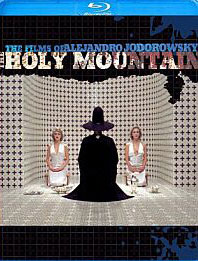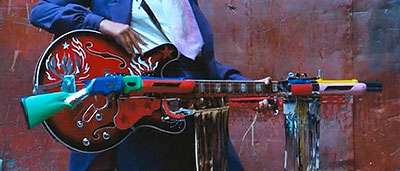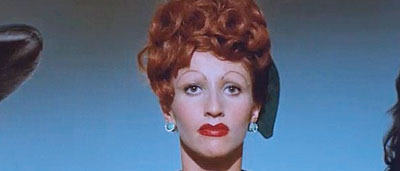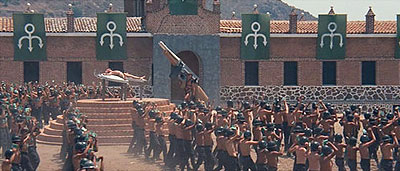The Holy Mountain: Does Real Life Await Us?
Published on December 5th, 2011 in: Blu-Ray, Dancing Ourselves Into The Tomb, DVD/Blu-Ray Reviews, Issues, Movie Reviews, Movies, Underground/Cult |
Preface
For those who have never seen an Alejandro Jodorowsky film, describing one seems a daunting task. Furthermore, once you have seen a Jodorowsky film, such descriptions prove to be a poor substitute for the experience itself.
At present, Jodorowsky is 82 years old. With a life full of many artistic accomplishments, a description of them all is beyond the scope of an analysis of his films, but some introduction is needed in the hopes of illuminating how his background has informed his art.
He was born in Chile in 1929 to Jewish Ukranian immigrant parents. Later, he lived in both Mexico and Paris, starting his own mime theater troupe and becoming immersed in the Panic Movement, a collective of performance artists inspired and influenced by Antonin Artaud and Luis Buñuel, and who included in their ranks Roland Topor, co-author of the screenplay for La Planète Sauvage.
Much of the symbolism and iconography of Jodorowsky’s films is influenced by religion and mysticism, so much so that a book (or at least a doctoral dissertation) could likely be written about each film examining nothing but those themes. For the uninitiated, this would be off-putting and overwhelming and may not stimulate the desire to see a Jodorowsky film. By focusing on some of the more immediate and thought-provoking aspects, however, I hope to encourage more film fans—as well as fans of art, spirituality, and counterculture—to delve into his complex, frequently beautiful, yet sometimes horrifying world.
While Jodorowsky’s El Topo depicts the main character’s search for enlightenment against a backdrop of deserts, hills, rocks, and caves, The Holy Mountain shows the quest of a group of nine people as they forgo material gratification (including burning their own vast fortunes) and embark upon a spiritual journey to the top of a mountain. Although The Holy Mountain is visually stunning in its usage of color, particularly when combined with the panoply of religious and mystical symbols it presents, perhaps the most striking aspect of the film is the social commentary contained in the introductions to seven of these nine people.

These seven are described as “the most powerful people on the planet.” Each represents a planet, but in the context of the narration—by an Alchemist who is portrayed by Jodorowsky himself—it seems that some of these planets are also alchemical elements. There is Fon, whose planet is Venus (alchemical symbol Copper); Isla (Mars, Iron); Klen (Jupiter, Tin); and Sel (Saturn, Lead). There is also Berg (Uranus,), Axon (Neptune), and Lut (Pluto). (These last three are more recently discovered planets and thus not included in Western alchemy.) This further reinforces their status as not only powerful but perhaps even contained within the physical make-up of the world itself. This becomes more nefarious when they introduce themselves to us and what they contribute to the world.
Fon says that his industry is the “comfort and beauty of the human body,” This involves “beds, mattresses, fabrics, clothing, cosmetics” and prosthetics. We see men modeling prosthetic chests, calves, buttocks, arms, and other body parts in a factory. There are also “artificial faces” that completely transform the wearer as well as makeup and other devices that “eliminate the appearance of death.”
Although plastic and cosmetic surgery has been around at least since Egyptian times, WWI and II demanded innovations due to disfigured soldiers. The article “Beautiful Body,” claims that “by the 1960s, plastic surgery was fully integrated into the medical establishment.” However, in 1973, when The Holy Mountain was made, there was likely not a “Top Ten List of Cosmetic Surgeries” performed. Worldwide statistics on plastic surgery weren’t even publicly available until 2010. Seeing hundreds of prosthetic faces falling off the assembly line in The Holy Mountain seems incredibly prescient, considering that there were 1.3 million cosmetic surgeries performed in 2010 in the US alone.
Next we meet Isla, who manufactures and sells weapons. “We are experimenting with a drug to create delusions of grandeur,” she says. We see soldiers rushing forward to impale themselves on bayonets mounted to the ground in some sort of testing facility. Furthermore, Isla adds, “The young generation needs arms for its marches and sit-ins.”

Colorful platform boots and guitars are fused with rifles; brightly-painted grenades are shown on feathered necklaces; there are Buddha statues, menorahs, and crucifixes attached to guns . . . all resemble Peter Max artwork. Again, this cynical marketing seems awfully prophetic when in this current millennium you can buy James Piatt’s “Pursuader” handbag for $379.
There is also Klen, who has a wife and a lover (“A thousand a week,” he says). His wife barely looks at him and wipes her hand with a cotton ball dipped in rubbing alcohol after he kisses it. He admires the creations at his “art factory.” There’s an assembly line of people, their naked buttocks covered in paint, making their marks on white paper to be sold as art, a commentary perhaps on the rise of the Pop Art movement, the popularity of Andy Warhol, and the notion of mass-produced, disposable art.
Klen’s sculptures show nude body parts such as torsos and arms, but no faces, which adds to the idea of the impersonality of it. Perhaps continuing in the mindset of Isla’s “weapons as fashion,” Klen says, “We produce a new line of art every season.” He’s even created a “love machine” which can be stimulated to orgasm and reproduce additional machines.
Like Isla, Sel also produces weapons, or as she refers to them, “war toys for children.” First we see her as a quasi-religious clown riding an elephant, leading a parade of dwarf and midget Santa Clauses and accompanied by a man dressed an angel. Then she changes into a severe 1940s style outfit and takes us on a tour of her factory. She narrates:
We have an electronic computer programmed with the politics of the government. The government is our client. We feed the computer data on coming wars and revolutions.
It tells us what kind of toys to produce to condition children from birth . . . for 15 years in advance, we condition children to hate the future enemy.
It would be difficult not to find such statements both disconcerting and terribly contemporary in 2011. Even though computer innovations such as the origins of the Internet, RAM chips, microprocessors, floppy disks, and Ethernet had just come into existence within a few years before the movie was made, such paranoia about their legacy seems less outrageous considering the capabilities of computers now—especially in the hands of governments.

Coming after Sel’s description of her work, and her apparent duplicity, Berg’s industry is no less appalling. He lives in a hovel with his buxom, oversexed, garishly made-up wife and tells us he’s the “financial adviser to the president.” He presents a report explaining “to save the country’s economy, we must eliminate four million citizens in the next five years.” He then sits, bored, under a pigeon coop, drinking tea with his wife. Berg is less distressed by the report’s directive than the bird crap he must constantly flick off the table in front of him.
As a follow up to the elimination of citizens, we meet Axon, the chief of police, who looks like Wez from Mad Max (which didn’t come out until six years later). He castrates a young man, and praises him for surrendering that part of his body “of your own free will” since now Axon can add it to his collection of 999 jars of testicles. The room has a small altar in which he encourages the boy to “read the holy book” and “learn to believe in me.”
Axon’s police state scenario ends with a group of student protestors marching with signs and subsequently attacked with explosions of colored gas. However, rather than show a gory massacre, the blood spilled is various shades of green and blue, while the protesters’ wounds are revealed to be colored scarves, sausages, watermelon, and cherry pie filling. It doesn’t make the slaughter any less aggressive and compelling, especially in light of the allegations of police misconduct at the 2010 G20 summit and the 2011 pepper-spray incident during the Occupy Wall Street protest on the UC Davis campus.

Perhaps most provocative is our introduction to Lut, an architect. After building a multi-family complex—which looks like a housing project full of people with missing limbs and other physical handicaps—he explains how he realized he made a mistake: “We lost money.”
Giving the residents small gardens, windows, water, and lighting and heating systems was a “wrong concept.” At a large dinner gathering, presumably comprised of shareholders or other members of industry, Lut claims that:
A man doesn’t need a home, all he needs is a shelter. If we can sell him on the idea of a shelter, we can make millions. A worker will come here only to sleep, he won’t need electricity or water. He won’t have to cook, we’ll condition him to eat at the factory. These are communal latrine trucks for the entire building.
As the dinner guests gnaw hungrily on roast Cornish hens, some of the women in attendance caress and lick an ice sculpture shaped like an erect penis. A male transvestite enters, accompanied by strip tease music and waving feathered fans. He and Lut coax a young woman, wearing nothing but cut-off denim shorts, into one of the shelters, which is shaped like a coffin. A scale model of the housing development is revealed to be rows on top of rows of these coffin-shaped shelters. Everyone in attendance applauds.
At the end of the movie, after leading the nine people to the top of the holy mountain, the Alchemist/Jodorowsky addresses them:
I promised you the great secret and I will not disappoint you. Is this the end of our adventure? Nothing has an end. We came in search of the secret of immortality, to be immortal like the Gods and here we are, mortals, more human than ever. If we have not obtained immortality at least we have obtained reality. We began in a fairy tale and we came to life, but is this life reality? No, it is a film. Zoom back camera. We are images, dreams, photographs. We must not stay here prisoners. We shall break the illusion. This is Maja. Goodbye to the Holy Mountain. Real life awaits us.

Here Jodorowsky has broken the fourth wall, but has he done something more? Although the events of the film may have been presented as a “fairy tale,” could the descriptions of the various industries of the seven powerful people be the “real life” to which he refers?
Despite its often-disturbing imagery, The Holy Mountain is not without humor, but rather than post-modern, cynical irony, it comes across as almost cartoonish, with garish, exaggerated colors and imagery. This is where Jodorowsky’s roots in surrealism become apparent. The Panic Movement itself was “designed to be shocking, as a response to surrealism becoming petite bourgeoisie and to release destructive energies in search of peace and beauty.” The ambiguity in the Alchemist’s final address to the audience is presented in a way that asks the viewer to decide. After all, Jodorowsky has led us on a journey, but he cannot tell us what to think or what to do next. That is up to us.
The Anchor Bay Blu-Ray of The Holy Mountain was released on April 23, 2011 and is available on their website.
The Blu-Ray features include:
—New HD transfer from 2K scan from original 35mm negative under the supervision of Alejandro Jodorowsky
—Original Aspect Ratio: 2.35:1 (Anamorphic)
—DTS-HD Master Audio 5.1 & PCM Stereo
—Feature Commentary by Alejandro Jodorowsky
—Original theatrical trailer
—Deleted scenes with commentary by Alejandro Jodorowsky
—The Holy Mountain restoration process
—Photo Gallery
—Original Script Excerpts
—English, French, Spanish, Brazilian, Portuguese subtitles
One Response to “The Holy Mountain: Does Real Life Await Us?”
December 31st, 2011 at 2:09 pm
[…] one of his movies. The recent Blu-Ray editions of El Topo and The Holy Mountain (reviewed here and here literally blew my mind. If there were more artists like Jodorowsky around, the world would be […]
Time limit is exhausted. Please reload the CAPTCHA.